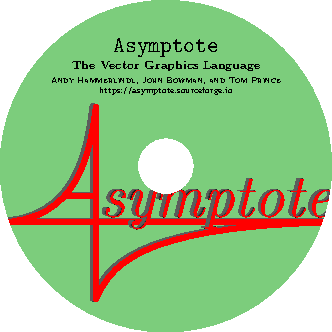4.4 label ¶
void label(picture pic=currentpicture, Label L, pair position,
align align=NoAlign, pen p=currentpen, filltype filltype=NoFill)
Draw Label L on picture pic using pen p. If
align is NoAlign, the label will be centered at user
coordinate position; otherwise it will be aligned in the
direction of align and displaced from position by
the PostScript offset align*labelmargin(p).
Here, real labelmargin(pen p=currentpen) is a quantity used to align labels.
In the code below,
label("abcdefg",(0,0),align=up,basealign);
the baseline of the label will be exactly
labelmargin(currentpen) PostScript units above the center.
The constant Align can be used to align the
bottom-left corner of the label at position.
The Label L can either be a string or the structure obtained by calling
one of the functions
Label Label(string s="", pair position, align align=NoAlign,
pen p=nullpen, embed embed=Rotate, filltype filltype=NoFill);
Label Label(string s="", align align=NoAlign,
pen p=nullpen, embed embed=Rotate, filltype filltype=NoFill);
Label Label(Label L, pair position, align align=NoAlign,
pen p=nullpen, embed embed=L.embed, filltype filltype=NoFill);
Label Label(Label L, align align=NoAlign,
pen p=nullpen, embed embed=L.embed, filltype filltype=NoFill);
The text of a Label can be scaled, slanted, rotated, or shifted by
multiplying it on the left by an affine transform (see Transforms).
For example, rotate(45)*xscale(2)*L first scales L in the
x direction and then rotates it counterclockwise by 45
degrees. The final position of a Label can also be shifted by a
PostScript coordinate translation: shift(10,0)*L.
An explicit pen specified within the Label overrides other pen arguments.
The embed argument determines how the Label should transform with the
embedding picture:
Shift¶only shift with embedding picture;
Rotate¶only shift and rotate with embedding picture (default);
Rotate(pair z)¶rotate with (picture-transformed) vector
z.Slant¶only shift, rotate, slant, and reflect with embedding picture;
Scale¶shift, rotate, slant, reflect, and scale with embedding picture.
To add a label to a path, use
void label(picture pic=currentpicture, Label L, path g, align align=NoAlign,
pen p=currentpen, filltype filltype=NoFill);
By default the label will be positioned at the midpoint of the path.
An alternative label position (in the sense of point(path p, real t))
may be specified as a real value for position in constructing
the Label. The position Relative(real) specifies a location
relative to the total arclength of the path. These convenient
abbreviations are predefined:
position BeginPoint=Relative(0); position MidPoint=Relative(0.5); position EndPoint=Relative(1);
Path labels are aligned in the direction align, which may
be specified as an absolute compass direction (pair) or a direction
Relative(pair) measured relative to a north axis
in the local direction of the path. For convenience LeftSide,
Center, and RightSide are defined as Relative(W),
Relative((0,0)), and Relative(E), respectively.
Multiplying LeftSide and RightSide on the
left by a real scaling factor will move the label further away from or
closer to the path.
A label with a fixed-size arrow of length arrowlength pointing
to b from direction dir can be produced with the routine
void arrow(picture pic=currentpicture, Label L="", pair b, pair dir,
real length=arrowlength, align align=NoAlign,
pen p=currentpen, arrowbar arrow=Arrow, margin margin=EndMargin);
If no alignment is specified (either in the Label or as an explicit
argument), the optional Label will be aligned in the direction dir,
using margin margin.
The function string graphic(string name, string options="")
returns a string that can be used to include an encapsulated
PostScript (EPS) file. Here, name is the name
of the file to include and options is a string containing a
comma-separated list of optional bounding box (bb=llx lly urx
ury), width (width=value), height (height=value),
rotation (angle=value), scaling (scale=factor), clipping
(clip=bool), and draft mode (draft=bool) parameters. The
layer() function can be used to force future objects to be
drawn on top of the included image:
label(graphic("file.eps","width=1cm"),(0,0),NE);
layer();
The string baseline(string s, string template="\strut")
function can be used to enlarge the bounding box of a label to match a
given template, so that their baselines will be typeset on a
horizontal line. See Pythagoras.asy for an example.
Alternatively, the pen basealign may be used to force labels to
respect the TeX baseline (see basealign).
One can prevent labels from overwriting one another with the
overwrite pen attribute (see overwrite).
The structure object defined in plain_Label.asy
allows Labels and frames to be treated in a uniform manner.
A group of objects may be packed together into single frame with the routine
frame pack(pair align=2S ... object inset[]);
To draw or fill a box (or ellipse or other path) around a Label and
return the bounding object, use one of the routines
object draw(picture pic=currentpicture, Label L, envelope e,
real xmargin=0, real ymargin=xmargin, pen p=currentpen,
filltype filltype=NoFill, bool above=true);
object draw(picture pic=currentpicture, Label L, envelope e, pair position,
real xmargin=0, real ymargin=xmargin, pen p=currentpen,
filltype filltype=NoFill, bool above=true);
Here envelope is a boundary-drawing routine such as box,
roundbox, or ellipse defined in plain_boxes.asy.
The function path[] texpath(Label L) returns the path array that
TeX would fill to draw the Label L.
The string minipage(string s, width=100pt) function can be used
to format string s into a paragraph of width width.
This example uses minipage, clip, and graphic to
produce a CD label:

size(11.7cm,11.7cm);
asy(nativeformat(),"logo");
fill(unitcircle^^(scale(2/11.7)*unitcircle),
evenodd+rgb(124/255,205/255,124/255));
label(scale(1.1)*minipage(
"\centering\scriptsize \textbf{\LARGE {\tt Asymptote}\\
\smallskip
\small The Vector Graphics Language}\\
\smallskip
\textsc{Andy Hammerlindl, John Bowman, and Tom Prince}
https://asymptote.sourceforge.io\\
",8cm),(0,0.6));
label(graphic("logo","height=7cm"),(0,-0.22));
clip(unitcircle^^(scale(2/11.7)*unitcircle),evenodd);